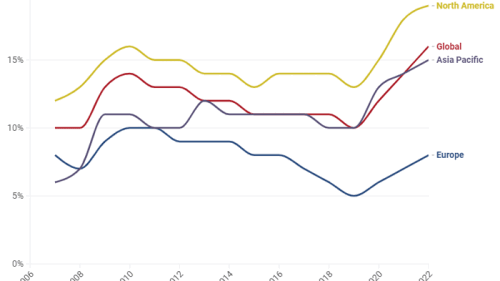Serious money is in play in the Bloomberg Philanthropies’ “Mayors’ Challenge” for cities competing to show they have come up with promising innovations to cope with 21st-century challenges.
Inaugurated in the United States in 2012, the competition has been transferred to Europe this year with a grand prize of €5 million ($6.7 million) for the winning city, as well as €1 million ($1.3 million) to each of four runners-up. The funds must be targeted at implementing the cities’ winning ideas.
But it isn’t just big-time prize money that sets this competition apart. Typical public sector awards acknowledge programs that have already proved successful. By contrast, the Bloomberg challenge is about sparking new and sometimes untested ideas for cities.
That is why teams of officials and private sector allies from 21 municipal governments across Europe convened in Berlin in early June for something called an “ideas camp.” Underneath the glass-paneled ceiling of the historic Humboldt Carré building, they worked together to “stretch, strengthen, and refine” their ideas for turning auto traffic into electricity, deploying mobile art units, and using gaming to combat youth unemployment, among other topics. (Click here for a full list of their ideas.)
Related: For Milwaukee, Losing the Bloomberg Mayors Challenge Was Still a Win
The camp process itself is a form of urban innovation in which competitors are turned into collaborators. In critique sessions, the city delegations peppered each other with tough questions and offered suggestions aimed at making everyone’s ideas stronger. To participants such as Paula Popoire Gomes, adviser of international social affairs from The Hague, the intensity of the collaboration came as a something of a shock.
“It was a big surprise to hear we’d share our ideas with competitors,” says Gomes. “But it works brilliantly. It’s exactly what you need—everyone sharing and trying to help each other. It’s crazy, but it works.”
Camp Counselors
The camp concept is not entirely an invention of the foundation created by former New York City mayor, business magnate, and philanthropist Michael R. Bloomberg. The design was developed by Nesta, a London-based nonprofit and self-described “innovation charity” that helps public and private organizations fertilize ideas.
James Anderson, formerly communications director for Mayor Bloomberg and now director of the government innovations team and strategic initiatives for Bloomberg Philanthropies, observed Nesta’s unusual approach on a trip to Great Britain. He notes: “I brought the idea back to Mike, who was immediately excited to bring it to the United States and adapt it.”
The Bloomberg team, Anderson explains, uses the process of competitive collaboration with three goals: “One, to inspire a bold round of public sector innovation, producing great ideas. Two, to test and spread the best of those ideas. And three, to inspire positive conversation about the role of cities and local government.”
If the sessions in Berlin serve as any indication, the formula seemed to work. The 21 teams, selected from 155 original entries, worked hard at perfecting their ideas but occasionally succumbed to outbursts of laughter. They had already received advance visits and advice by a team of Monitor Deloitte management consultants—commissioned, notes Bloomberg’s Andrea Coleman, to counsel applicants about where to stretch their ideas, or alternatively to pare them down to essential elements.
In Berlin, the city teams were coached by veterans of city policy battles such as Bloomberg’s New York City planning director Amanda Burden and his health and human services director Linda Gibbs on how to cultivate stakeholders, learn lessons, and deal with obstacles. (Burden and Gibbs are members of the newly formed Bloomberg Associates consulting group, housed at Bloomberg’s Manhattan quarters but not part of the actual foundation operations.)
Post-Berlin, the focus turns back to competition. The finalists now have until July 31 to submit new proposals informed by their ideas camp learnings. The Bloomberg team told them to build their revised plans around an assumption of receiving €1 million, not the full €5 million. Other advice: Create innovations that are brave but also practical. Communicate with a single voice. Show the importance of investment. Focus on metrics and measurement—but also inspire.
A judging jury of European public sector, think tank, academic, and other experts in public innovation will meet on September 17; the winners will be publicly announced in October.
The U.S. Round
All of this builds on the previous round of the Mayors’ Challenge in the United States. That round generated applications from more than 300 cities.
Providence, Rhode Island, emerged as the winner when results were announced in early 2013. The city received $5 million to take on the issue of very low vocabulary exposure for children in low-income households. The funds are helping to test a program working with families to monitor and increase the number of words their children hear in a day, giving them a better chance of succeeding at school and later in life.
Among the 2013 runners-up (receiving $1 million each) was Houston’s “One Bin for All” recycling program. The aim: to increase the city’s recycling rate from an abysmal 14 percent to a staggering 75 percent by giving residents one bin for all their trash and using technology to sort it after collection.
Anderson felt the initial round was “a home run,” with each city producing an idea “that has the potential to really disrupt the status quo and change policy and practice” on issues of governance and quality of life in cities. A side goal is to create a sort of family of urban entrepreneurs in different cities. Representatives of U.S. winners flew to Berlin to offer advice to this year’s round of contenders.
Even some of the cities that did not win the last time found advantages to participating. Milwaukee’s idea to turn foreclosed properties into urban farms was one of 20 finalists in the U.S. round, but it did not finish in the money. Still, the competition gave municipal leaders a platform to spark a positive public discussion about food and farming. Milwaukee moved ahead with the program without the prize money, says the city’s sustainability director, Matt Howard.
“Despite not winning the money, which I would have preferred,” Howard says, “being in the competition has opened a lot of doors for us.”
Building on Others
In Berlin, the city teams worked at tables, charting out their strategies. The essential idea, as Anderson explains, is to make their plans more innovative, clear, and viable in the real world of city governance. A starting challenge is a poster exercise. The teams were told to sketch their concepts on a poster on the premise: “If you can’t draw it, it’s too complicated.”
The city teams were counseled to develop projects that were bold, visionary, adventuresome, and edgy. And, where possible, to make their projects transformational in the process—not winner-take-all (often the case in business) or mired in bureaucracy (as frequently in government), but aimed at consumer-oriented improvements in quality of service.
The questions kept flowing: Is a project visionary? Insightful? Possible to be implemented in the real world of city governance? And could it be transferred to other cities? The challenge ahead for each of the competing cities will be to incorporate those fresh aspects into their final proposals.
Most of the Berlin sessions were open to media observers, but not when the city teams actually critiqued each other’s ideas.
After the sessions, members of the city delegations did speak positively—even wonderingly—about the sessions. There was little dissent from their enthusiasm—that peer-to-peer critiquing produces a flow of ideas that can enrich urban innovation, create new channels of communications, and foster new possibilities for cities, in tangible ways.
The submissions focused on social and quality-of-life issues, especially projects to stem high unemployment across much of Europe. The ideas were shy on the side of fundamental government reforms, such as major changes in mayoral power, restructuring of city departments, civil-service reform, or changes in public employees’ rights.
But don’t discount the vital role of local services and policy innovation at the local level, Bloomberg noted in his camp remarks. National and state or provincial governments, he said, “typically just reallocate funds” and “are so far removed from the day-in and day-out problems of the real world.” By contrast, he noted, “delivery of services occurs at the local level. You pick up the garbage or you don’t. You stop crime or you don’t. You educate the kids or you don’t. You create jobs or you don’t.”
Those are the reasons, he said, that cities—even as they compete on many fronts—need to confer, compare, and exchange fresh ideas to improve the opportunities and living conditions for their citizens: “That’s how science goes on and the arts develop,” Bloomberg said. “You build on what other people do.”
Neal Peirce is the founder and editor-in-chief of Citiscope, a nonprofit news outlet that covers innovations in cities around the world. More at Citiscope.org.






